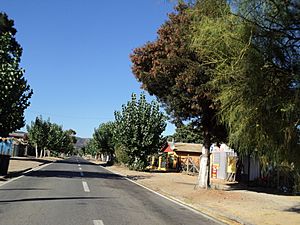Navidad, Chile facts for kids
Quick facts for kids
Navidad
|
|||||
|---|---|---|---|---|---|
 |
|||||
|
|||||
| Country | |||||
| Region | |||||
| Province | |||||
| Government | |||||
| • Type | Municipality | ||||
| Area | |||||
| • Total | 300.4 km2 (116.0 sq mi) | ||||
| Elevation | 24 m (79 ft) | ||||
| Population
(2012 Census)
|
|||||
| • Total | 5,324 | ||||
| • Density | 17.723/km2 (45.902/sq mi) | ||||
| • Urban | 712 | ||||
| • Rural | 4,710 | ||||
| Sex | |||||
| • Men | 2,878 | ||||
| • Women | 2,544 | ||||
| Time zone | UTC-4 (CLT) | ||||
| • Summer (DST) | UTC-3 (CLST) | ||||
| Area code(s) | (+56) 72 | ||||
| Website | Municipality of Navidad | ||||
Navidad (pronounced "nah-vee-DAHD") is a small town and area in Chile. It is one of six communes (like a local district) in the Cardenal Caro Province. This province is part of the O'Higgins Region of Chile.
Navidad is located on the coast. To its north, it shares borders with Santo Domingo and San Pedro. To the east and south, it borders the commune of Litueche. The Pacific Ocean is to its west. Navidad has about 20 kilometers (12 miles) of beautiful coastline.
Contents
People and Population
In 2002, a study by the Chilean National Statistics Institute found that Navidad covers about 300.4 square kilometers (116 square miles). At that time, 5,422 people lived there. This included 2,878 men and 2,544 women.
Most people in Navidad live in rural areas, which means outside of towns. About 4,710 people (86.9%) lived in rural areas. Only 712 people (13.1%) lived in the main urban areas. The number of people living in Navidad stayed almost the same between 1992 and 2002.
Natural Features
The land in Navidad mostly has flat areas, rolling hills, and deep valleys. These are common features along the central coast of Chile. The Rapel River is the main source of water for the area. There are also smaller streams and lagoons, like El Culenar.
Navidad is famous for a special geological feature called the Navidad Formation. This is a layer of marine rock that holds fossils of sea creatures. These fossils are very old, dating back about 5 million years ago. This time period is known as the late Miocene to early Pliocene eras.
Many scientists have studied these rock formations. The famous English naturalist Charles Darwin explored them in the 1800s. A French scientist and painter named Claudio Gay also studied the area for the Chilean government. Later, a German geologist named Rodolfo Philippi also examined the unique rocks of Navidad.
The modern town and its borders were officially set up on September 28, 1936. The main local government offices were placed in the town of Navidad. This was the largest town in the area.
The name "Navidad" means "Christmas" in Spanish. There are a few stories about how the area got this name.
Early Mentions
In 1585, a Franciscan friar named Diego de Medellín wrote to the King of Spain. He was the third bishop of Santiago. He wrote about the local people and mentioned Navidad, Rapel, and Matanzas. This shows that the name "Navidad" was used very early on.
The Christmas Eve Story
One popular story says that on a Christmas Eve long ago in the 1500s, the first Franciscan friars arrived at the port of Matanzas. They celebrated Christmas there and stayed in the valley for several days. Because they celebrated Christmas there, they called the place Navidad.
The Jesuit Connection
Another story suggests that the name Navidad came from the Jesuits. There was a Jesuit convent in a nearby place called Bucalemu. The Jesuits were important in teaching the native people. They taught them about religion and also various artisan skills.
It's important to know that none of these stories are fully proven.
Local Government
Navidad is a commune, which is a local administrative area in Chile. It is managed by a municipal council. The leader of the commune is called an alcalde (mayor). The alcalde is chosen directly by the people every four years.
The current alcalde for Navidad, serving from 2021 to 2024, is Yanko Blumen Antivilo.
Navidad has a Mediterranean climate. This means it gets rain from April to October and has dry, sunny summers. The coastline is often windy and has big waves. This makes it a very popular spot for surfing.
Farming Traditions
Navidad also has a strong history of farming. One interesting event you can see there is the (Trilla a yegua suelta) festival. During this festival, mares (female horses) are driven freely over harvested wheat. This helps to separate the grain from the outer husks, called chaff. It's a traditional way of harvesting that is fun to watch!
Towns and Villages
Some of the towns and villages located in the Navidad commune include:
- Rapel
- Licancheu
- Culenar
- Navidad
- Las Brisas
- La Boca
- Vega de La Boca
- Matanzas
- Pupuya
- Pupuya Sur
- El Fullingue
- Centinela
- El Manzano
- Tumán
- La Polcura
- Valle negro
- Puertecillo
- Valle Hidango
- El Manzano
- San Vicente de Pucalán
- Quiñecaben
- La Aguada
- Lagunillas
- El Chorrillo
- Potrero de San Rafael
- La Patagûilla
- El Maitén
- Vega de Pupuya
See also
 In Spanish: Navidad (Chile) para niños
In Spanish: Navidad (Chile) para niños




